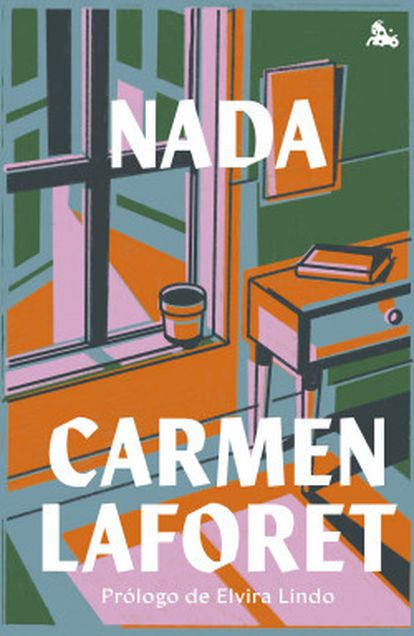There are novels that accompany us throughout life and that in each of the stages we go through seem to add a new quality to our first perception.
So it is with
Nothing
, this book that I hold today in my hands, which were once those of a sixteen-year-old teenager eager to find her equals in literature.
The high school girl I went to felt immersed in the adventures of that peculiar and attractive girl who arrives in Barcelona the first fall after the civil war.
The hunger, the economic hardship, the cold, the shadow of the war were aspects less present to my eyes at the time than the powerful feeling of being united to that girl, Andrea, in her loneliness in the face of a hostile world, in search of shelter. at times when emotions are so strong that they hardly know how to express themselves or share them.
That was my Andrea at that time, with whom I shared an age and who served as the exact definition of my mass: a strange girl, of unorthodox femininity,
sensitive to literature, confused by the impulses of love, eager to find soul mates who would make the nature of threatening adults more understandable.
The context, therefore, was buried in my reading by the inner life of a protagonist with whom I felt intimately identified.
That has been the case then and always for those who read in a formative period: adolescents try to find their self in each story they read.
There is no literary adventure that one lends himself to in those years if the stimulus of identification is not found.
It remained buried in my reading by the inner life of a protagonist with whom I felt intimately identified.
That has been the case then and always for those who read in a formative period: adolescents try to find their self in each story they read.
There is no literary adventure to which one lends oneself in those years if the stimulus of identification is not found.
I was buried in my reading by the inner life of a protagonist with whom I felt intimately identified.
That has been the case then and always for those who read in a formative period: adolescents try to find their self in each story they read.
There is no literary adventure that one lends himself to in those years if the stimulus of identification is not found.
Beyond that first reading, the years have made me renew, not once but several times, my passion for this novel and for the twenty-three-year-old woman who had written it.
Nada
's publication story
it is in itself so infrequent in a country like ours that it is not possible to ignore it, no matter how many times it is a chapter narrated in prologues and essays that give an account of the back room of our literature.
The young Laforet wrote the book in Madrid, after spending two years at the university in Barcelona.
She showed it to the only friend she could trust with her writings, the journalist and editor Manuel Cerezales, who some time later would become her husband and father of her children.
Cerezales liked it and encouraged her to apply for an award that had just been announced for the first time: the Nadal, promoted by the magazine Destino.
Its organizers created the award with the aim of renewing the depleted Spanish literary scene after the war,
and contribute to the existence of new voices that would reconstruct a kind of cultural universe in the suffocating environment that Franco's victory brought with it.
The announcement of the award caused enthusiasm among writers and the rumor spread that the award would go to the hands of the journalist César González Ruano.
This would have been the case if it hadn't been for the fact that at the last minute the jury received a novel that, according to what is narrated in the intrahistory of the award, was read almost in one go the night before the ruling.
Nothing was known about who could have written this book with echoes of the Brontë sisters and, in a certain sense, of the
This would have been the case if it hadn't been for the fact that at the last minute the jury received a novel that, according to what is narrated in the intrahistory of the award, was read almost in one go the night before the ruling.
Nothing was known about who could have written this book with echoes of the Brontë sisters and, in a certain sense, of the
This would have been the case if it hadn't been for the fact that at the last minute the jury received a novel that, according to what is narrated in the intrahistory of the award, was read almost in one go the night before the ruling.
Nothing was known about who could have written this book with echoes of the Brontë sisters and, in a certain sense, of the
Rebecca
by Daphne du Maurier.
The point of view corresponded to the unmistakable voice of a young woman, very young, who portrayed her passage through a Barcelona still in ruins after the war and in which, on the one hand, characters wounded by the experience appeared, and on the other, young people trying to escape the prevailing vulgarity.
The writer Elvira Lindo, in 2020. © Carlos Rosillo
The jury, fascinated by that strange voice that had a poetic pulse a present that until now had not been narrated, decided to be guided by its nose and awarded the prize to this unique story that turned out to have been written by a woman only five years older than the protagonist of the novel.
Upon locating its author in Madrid, they were fascinated and surprised by the personality of a writer outside the literary universe, who had written the story guided by an innate gift for language, using a unique prose that seemed uncontaminated by any influence.
The young people who then read Andrea's story proudly declared themselves members of the
Nada
generation .
They felt, as those who were then young people on their way to adulthood have recounted, that the book defined them, that their life was being narrated for the first time as it was.
Perhaps this intense generational identification came about because the style did not respond to the most hackneyed social realism nor was it a faithful description of the atmosphere of the time, but rather took flight thanks to a metaphorical language, at times existential, at times magical, gothic, tremendous, favoring the free interpretation of the readers.
Everyone saw in
Nothing
what his lonely heart sought.
That is the reason why the novel has sailed lightly through time.
Her heroine, Andrea, adapts to what each reading requires and today adolescents like the one I was experience the same fascination that overwhelmed me, and readers already in adulthood are carried away by the vicissitudes of that lonely girl .
Carmen Laforet could not help feeling overwhelmed by the overwhelming success of her first novel.
In a country so yearning for new faces and airs of hope, the young Ella aroused an unprecedented interest to which she responded with timidity, hesitation, modesty, sometimes clumsily.
She was not prepared, that first-time novelist, to face an environment as resistant to innocence as the literary one was, and often is.
She could not help becoming, despite her youth, a benchmark for other young writers who had never contemplated the possibility of applying for an award and winning it.
But her connection was not only with the young audience, writers from exile and from the interior enthusiastically applauded Laforet's premiere.
Ramón J. Sender, Elena Fortún, Juan Ramón Jiménez, as well as the very young Juan Eduardo Zúñiga, Ana María Matute,
Nothing
and contributed to place it from the outset in a privileged position in the canon of the post-war Spanish novel.
What came after
Nada
's immediate popularity is not without mystery.
Laforet wrote a considerable work step by step by dint of fighting against the pressure of the publisher and against her own emotional blockage, which led her to a kind of paralyzing perfectionism.
In these days so close to the centenary of her birth, it would be desirable that the novels that followed that first were read with the interest they deserve to break the inaccurate curse that has ended up defining her as the author of a single work.
Despite pregnancies, domestic obligations, five children, divorce and life between bohemian and vagabond, Carmen Laforet was always a writer, a job that corresponded to her most intimate nature, although her elusive character did not favor the diffusion that the work of her deserved.
Thinking about her, working on her literature in this and other works, I have concluded that Laforet was an anachronistic woman.
She was not at all a daughter of her time, so that she would have been more understood in this present of ours;
her character independent of her, pure of her, averse to cultural gossip, could have moved comfortably on the margins of her, as she liked, thus responding to the yearning for freedom that drove her creative engine.
But it was not only the time that failed young Laforet, nor was the country in which she saw her first success blossom the ideal one for a peculiar young woman, who did not accept the formalisms that governed the lives of women.
That face that looks at us from the photos of the forties and fifties is that of a woman of today, of little corseted beauty, natural, with short and disheveled hair,
wearing practical clothes and comfortable shoes, with an adventurous aspect, as if she were ready to walk and flee from one place to another, to enjoy nomadism, to leave home eager to see new worlds and return later to the heat of theirs.
That refractory spirit to the time in which she had to live, that deprived her of the future where the so-called "rare girl" would have fitted in, that lack of fit in a Spain where she was suffocating, as she wrote to Sender upon returning from the United States, are two factors that help us understand them, her and her work,
Nothing
, where the characters are at times ghostly apparitions that threaten the young Andrea with violating her innocence.
What is
Nothing
but the story of a pure spirit that does not find its place in the world?
'Nothing', by Carmen Laforet.
Foreword by Elvira Lindo.
Southern, 2022. 304 pages.
€12.95.
You can follow BABELIA on
and
, or sign up here to receive
our weekly newsletter
.



/cloudfront-eu-central-1.images.arcpublishing.com/prisa/36G4ANCQ6RFRHGVVT4A7VRWFTM.jpg)





